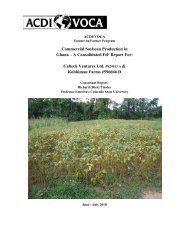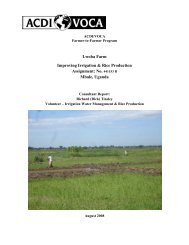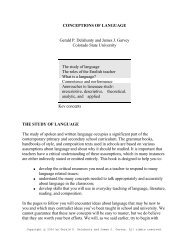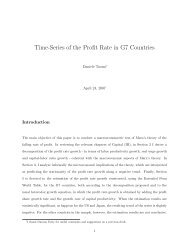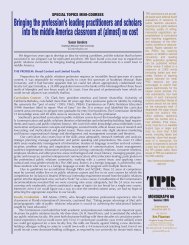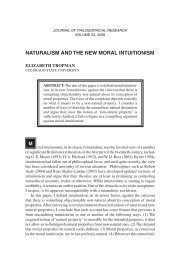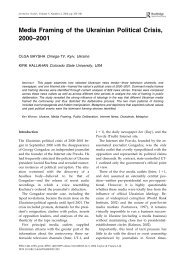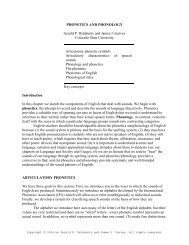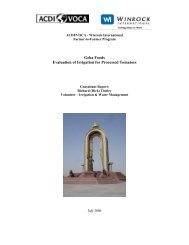Trail Log 1995-1997 - Lamar at Colorado State University
Trail Log 1995-1997 - Lamar at Colorado State University
Trail Log 1995-1997 - Lamar at Colorado State University
You also want an ePaper? Increase the reach of your titles
YUMPU automatically turns print PDFs into web optimized ePapers that Google loves.
63<br />
<strong>University</strong> of Cape Town. Lovely drive. Lovely city in a lovely setting. The Portuguese were the<br />
first to sail around the Cape of Good Hope, looking for a route to India. The Dutch first settled here<br />
in 1652. The British came in 1806. We continued, south to Muisenberg, and then drove down the<br />
east side of the peninsula, th<strong>at</strong> is, the western side of False Bay. Through Fish Hoek, Simon's<br />
Town, and on down into the Cape of Good Hope N<strong>at</strong>ure Reserve. Marvelous scenery down the<br />
coast.<br />
We reached the Cape of Good Hope N<strong>at</strong>ure Reserve about 10.30. Bartholomeu Dias with three<br />
small ships rounded the cape in 1487 and named it Cabo de Boa Esperanca. Ten years l<strong>at</strong>er, in<br />
1497 Vasco da Gama came round the cape and made it all the way to India. This is fynbos, low<br />
to waist high brush, pruned down by the wind, often many rocks. There are almost no n<strong>at</strong>ive trees.<br />
It is reminiscent in many respects of the Scottish coastal highlands.<br />
We went first to the Cape of Good Hope, the southernmost point, which is low by the sea. 3-4<br />
ostriches going in. There were impressive breakers coming in; we w<strong>at</strong>ched them in awe for a while.<br />
Then we drove around to Cape Point, which is high. You park and walk up, 20 minutes climb, to<br />
an observ<strong>at</strong>ion point with an unused tower on it. Lots of people here.<br />
We returned to the car, drove back around to the cape and had lunch, w<strong>at</strong>ching the breakers.<br />
(various pix)<br />
Returning, a nice group of bontebok, stopped and w<strong>at</strong>ched them a while. This antelope is restricted<br />
to the Cape area, richly colored, grouped by some in the same species as blesbok. Neither had<br />
all th<strong>at</strong> much range; both are much reduced in numbers.<br />
Continuing, drove up the west coast of the peninsula, i.e. the Atlantic Ocean side, with more<br />
spectacular driving on a road cut into the coastline, especially the Chapman's Peak stretch. A<br />
couple of baboons <strong>at</strong> one point along the roadside. Clouds continued to enhance the scenery.<br />
Returned on M63 by the Kirstenbosch Gardens area, and picked up the M3 used earlier in the day.<br />
Back <strong>at</strong> the fl<strong>at</strong> by about 5.00 p.m. Quite a memorable and scenic day, <strong>at</strong> the bottom of Africa.<br />
August 7. Monday, lecture <strong>at</strong> <strong>University</strong> of Cape Town<br />
Cloudless day. We drove down with Ian Voges; met with Roy Siegfried, Fitzp<strong>at</strong>rick Institute of<br />
Ornithology, <strong>University</strong> of Cape Town, <strong>at</strong> 11.30 a.m. Lunch with philosophy dept., and seminar with<br />
them and gradu<strong>at</strong>e students afterward. Then drove by the w<strong>at</strong>erfront shopping area. Cape Town<br />
in all its beauty.<br />
August 8, Tuesday. In the morning, met with Charlie Boucher, Department of Botany, and an<br />
ecologist and conserv<strong>at</strong>ionist here. Toured the herbarium. Their research herbarium is soon to be<br />
moved to Kirstenbosch. The biggest herbarium in the country is <strong>at</strong> Pretoria, the N<strong>at</strong>ional Botanical<br />
Institute, a government agency. Kirstenbosch has now been made part of th<strong>at</strong> also. Checklist of<br />
the mosses was done by Bob McGill; I looked <strong>at</strong> a n<strong>at</strong>ional flora th<strong>at</strong> listed them.<br />
Arnold, T. H., and B. C. de Wet, eds., Plants of Southern Africa: Names and Distribution. Pretoria:<br />
N<strong>at</strong>ional Botanical Institute, 1993. 825 pages. ISBN 1-874907-03-X. South Africa has the richest<br />
temper<strong>at</strong>e flora in the world, approxim<strong>at</strong>ely 24,500 species (or infrageneric taxa), almost 10% of<br />
the world's flowering plants. This list is from the N<strong>at</strong>ional Herbarium system, a computer-based<br />
flora. The first part of the list is bryophytes, some forty pages.





